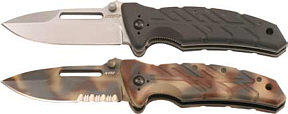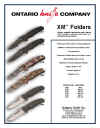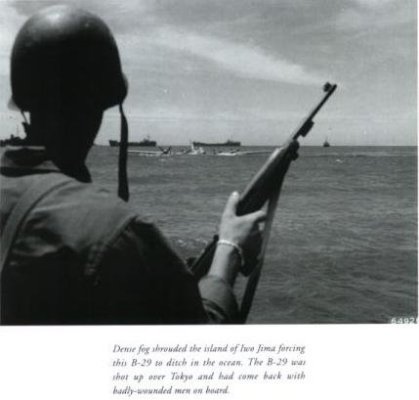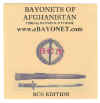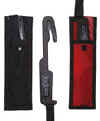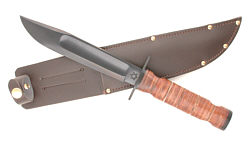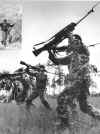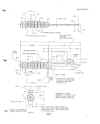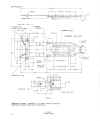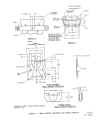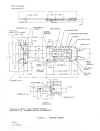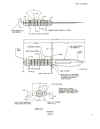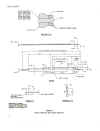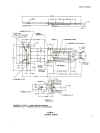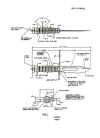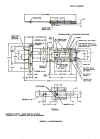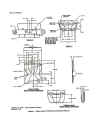February 2007
Quote:
Behold, I have created the smith that bloweth the coals in the fire, and that bringeth forth an instrument for his work ~Isaiah 54:16
Research in the Future
Trying to put all of this together someday will be enough to drive even the best man crazy. With the COTS (Commercial Off The Shelf) purchases, the military issues some very interesting items. In our narrow little field of anything with an edge we are lucky I guess to narrow it down just a bit. The number of companies making bayonets is few so that part is fairly selective although many companies in the past were not even knife makers so it is always a chance of the draw as to the manufacturer. The tricky part is the actual item model, not really the manufacturer. Most of the items are marked and had enough differences as to see one will set it apart from the others. For instance a future collector looking for a Camillus CQB1SG will easily be able to tell what it is but will be hard pressed to tell if it was a military issue version. As we explained in an article on this piece some time ago the only way to tell the difference is in the box the item comes in, the knives are exactly the same as a commercial piece sold at a gun show or on the internet.
Another aspect is the paper trail of the items. With items being listed in a computer database and announced in the Commerce Business Daily we have a record but how long will these be retained? In the National Archives we have paper from the birth of the country, our predecessors were savers. The older generations saved everything and filed it fairly efficiently for future usage. If only it were so today. E-mail is notoriously deleted when the computer slows down. Nothing devious about it although in some cases there may be, but it is just a typical operation today to delete e-mails. Old paper letters were not typically trashed but instead filed even if the user knew they would never be needed again. As the government grew so too did the paper use. We just couldn’t possibly store all that paper. Microfilm and microfiche save tons of space in the old paper would and documents were typically transferred to so form of easy and compact storage. There was still a trail even if you didn’t hold the original in your hands it was a copy of the original and you could read it and all the pre and post letters in sequence. Today with a tap of the delete key and a click of the mouse it is gone. Worse yet if a system failure as in a crashed hard drive. In this case even the information you wanted to keep is destroyed. Back ups and masters are great but even in my limited IT experience I have witnessed information just disappear.
Add it all up, varied models that are almost unidentifiable, not savers as out forefathers were and system limitations it all adds up to a nightmare for the guy trying to document our hobby 50 years from now.
Sample of a Few New Contract Items;
Ontario Knife Company XM series Folders
NSN 1095-01-535-5743, Ontario Part number 8765, Govt Part number XM-1DSIt is a Desert Camo Serrated folding knife. 44 were solicitated in SPM7L2-07-T-0664 issued on 12/7/06.
NSN 1095-01-535-5733, Ontario Part number 8755, Govt Part number XM-1SIt is a Bead Blasted Serrated folding knife. 5 were solicitated in SPM7L2-07-T-1746 issued on 12/5/06.
NSN 1095-01-535-5724, Ontario Part number 8750, Govt Part number XM-1It is a Bead Blasted Non-Serrated folding knife. 1 was solicitated in SPM7L3-07-T-3368 issued on 06/06/06.
Strider Knives Inc
NSN 1095-01-531-5015, Strider Part number SMF, Govt. Nomenclature: Knife, Folding Special Mission.
The solicitation is for 14 under request No. SPM7L4-07-T-0565 issued 12/1/06NSN 1095-01-531-5015, Strider Part number SMF, Govt. Nomenclature: Knife, Folding Special Mission.
The solicitation is for 17 under request No. SPM7L4-07-T-0713 issued 12/7/06There were at least 7 separate purchases of the Strider folder listed above in 2006 to look for.
Camillus Cutlery Co. 18- X-Ray
NSN 1095-01-533-9377, Camillus Part number 2536, Govt. Nomenclature: Knife, Combat (great choice of nomenclature there, nothing at all confusing, imagine 50 years from now) This solicitation is for 900 under request SPM7L4-07-T0044 issued on 10/13/06.
Still Looking for Life Raft Knife
A recent solicitation for knife purchase by the government caught our eye. It was listed as a "Knife, Combat with Lanyard", something we had not seen before. The Mark 2 is listed as a "Knife, Combat with Sheath" so we were thinking it would be around that line of knife. Further investigation proves it to be a Life-Raft knife. Looking up the NSN on the item (1095-01-350-1525), shows many have been purchased over the past year by the Aerospace Weapons Group out of the Defense Supply Center, Columbus. Well we are at a loss at to what one looks like. We do know of many life raft knives in the past but this one is a newer issue piece that sells for $33.90 each. Over one thousand purchased recently and the latest proposal list a one year open ended contract which could prove to be very large but not exceed $100,000.00. Again we are looking for help on this one, What does a Mark 3 Life-Raft knife look like?? The description is NSN 1095-01-350-1525, KNIFE, COMBAT. This item is being procured in accordance with a code and Part Number RFD Beaufort Inc. CAGE 074V1, P/N 2RA1211 – 1.

Here we have the Winslow raft with the well marked location of the knife

This is an RFD knife, is it the newest Military Life Raft Knife
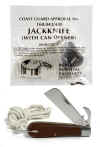
This is the Revere RFD Jack knife that is Coast Guard Approved

Here we have a Revere RFD Floating Life Raft Knife

The Life Raft ZIP knife. Strictly a line cutter, no other utility features on these.

The Hoover Life Raft ZIP knife, also lacks utility.
Datrex Life Raft Jack Knife include in sea survival kit.
This is pure speculation but the only MK3 aircrew knife I know of is the British issue curved blade model. If in fact this is the knife I would sure like to see one in US military trim and how they carry it. The MK 3 is carried in the flyers leg pouch made into the flight suit. In a life raft it would be set into a pouch inside one of the walls. In any case it is all speculation on this part, the call for the knives is real, just what they look like is still a mystery to me.
Did you Know…
Department of Transportation
Federal Aviation Administration
Office of Airworthiness
Washington, D.C.TSO-C70a
Date: 4/13/84
Technical Standard OrderSubject: TSO-C70a, LIFERAFTS (REVERSIBLE AND NONREVERSIBLE)
5.8 Knife. A hook type knife secured by a retaining line must be sheathed and attached to the liferaft adjacent to the point of mooring line attachment.
This is the actual line in the code book that requires all liferafts to have knives in them. The idea being to cut mooring lines if several rafts are lashed together, lashed to a sea anchor or any other floating object in peril of sinking and pulling the life raft down the mooring line could be quickly cut. The knife as we know it is not really a utility item but much more of a specialized tool for cutting rope. The typical WW II era knives with the concave sharp edge and the rounded point is still the design of choice in the rafts but some of the materials have changed. Cork, used in the early knives has been replaced with plastics in just about every case. The knives are still required to float but all are attached to the raft by a lengthy lanyard to prevent accidental loss overboard. Rafts are also marked plainly and in large letters KNIFE in the area of the knife storage compartment for quick and easy identification. Searching around the net we find several items that "COULD" be the item but we are looking for a positive identification by someone in the know or some one with access to the documentation to preserve this for the future generations.
D-Day Fighting Knife
I get this question quite a lot, lately it has increased even beyond the typical frequency. They are being sold by a popular militaria house and are getting spread all over the place. They have been selling for quite a few years so the numbers of them out there is probably fairly large. Having been around for awhile now natural age is making them look old as well. These are fantasy items of the extremely rare emergency issue fighting knives used by British, Free French and other Allied troops. Originally using a 6 1/2" blade section from a British No. 4 Mk1 (1933 variation I would guess) spike bayonet mounted on an all steel hilt. Ron Flook shows one in his book, British and Commonwealth Military Knives, in Plate 269 that is nickel plated with a lathe turned brass grip that was owned by a member of No. 6 Commando. Stephens shows the very same knife in his book, Fighting Knives, although he miss-identifies the construction materials. This example is a private custom made item. I have only seen a few and all of them were made on the No. 4 Mk II or later cylindrical type bayonet blade. Issued in slightly modified British #4 spike bayonet scabbards the originals of this model are now very rare.
A fascinating piece of WW2 Invasion equipment, new made D-Day Lebel Fighting knife w/scabbard? OK so how did they get hold of all those of French Lebel bayonets in England to cut them down when the German Army had control of France? Curious no?
Quote:
I know collectors with 40,000 bottles of wine who if you poured them a glass of Gallo Hearty Burgundy wouldn’t know the difference.Robert M. Parker Jr.
1904 Krag Bayonet
This one is a real killer to even think about. I have heard of a 1904 dated Krag bayonet, but have never seen a real one. We have seen and heard of some that were converted from other years by way of some enterprising individual over-stamping a prior year version. Supposedly they are out there or at least were out there but we have not held or seen one from any credible source to in fact say they were made. The search continues for a 1904 dated example that is real. On another front we have known for some time of the 900 Krag bayonets listed in the Bayonets, Knives and Scabbards Project Supporting Paper as being made in 1942. On the surface this seems incredible that Krag bayonets would have been made during war time in the government arsenal. Why we ask? Never having any information on the topic to follow up on we let it go. Just something to keep in the back of the mind for use at a later date. What do they look like? How are they marked? Dated or undated? In any case it would seem at least one would have surfaced over the years. Then we speculated it could have been a program to rebuild 900 that was just listed wrong in the report. But all is just speculation anyway so just keep on looking for the answer. Well we can’t say we have it for sure but the best speculation so far is the Sedgley Krag bayonet. At the start of WW II all the rifles that could still be used were requested back from colleges, military academies and ROTC programs all over the US. To fill this gap a commercial gun company out of Philadelphia Pa. Sedgley built some rifles, M1903 type and bayonets, M1892 type to supply these organizations with items to drill with. The US government purchased these Krag bayonets for issue to: Virginia Military Academy, Pennsylvania Military College, Minnesota State Guard and even the OSS among others. This would account for the 900 Krag bayonets listed as procured in 1942. While we don’t have the actual records to account for 900 in two months of 1942 we feel certain this is the best speculation so far.
On the Battlefield…
George Cary Eggleston in his great book Southern Soldier Stories, first published in 1898, tells us of a saber duel between two trained swordsmen at the Battle of Brandy Station. Eggleston titled the book Stories because some of the stories came from his friends. He wanted it noted that he was there at these places but may not have witnessed every detail himself. He was a master story teller as the book will prove out. He also had a wonderful view of the war, he writes as if he were an officer having knowledge of many events but he was an enlisted man. In fact he was JEB Stuarts clerk so his position to know more then typical bits of a story put him in a perfect position to tell the "stories." In any case the saber duel is told like you were there and is spoken like you were talking to a friend. Eggleston tells us that the battle stopped as both sides and paused to watch these two master swordsmen battle it out on the field. The Union man had just killed a Confederate Captain with his saber so the Confederate asked permission from his superior officer to engage the Union swordsman one on one, mano a mano . His Captain knew of his qualifications as a superior swordsman and released him from his duties to challenge the Union man. At the first pass Eggleston remarked that sparks flew from their blades as the two warriors crossed paths. Turning at the end of his gallop, the Confederate rider threw his saber to the ground and approached the Union man at the walk holding his reins low and his arms by his sides. He was approaching his enemy unarmed, his own lines became quiet to see what the man would do next. The Union trooper leaned forward and after staring, lowered his blade as well and slowly approached the unarmed enemy. The two shook hands, spoke for some short time, whirled their mounts around and returned to their respective lines ceasing the fight. As he passed by his Captain, the Confederate simply said "That man is my brother." They were twins from Maryland.
Quote:
Hard charging Air Force General Curtis LeMay had this suggestion for the North Vietnamese issue:
"My solution to the problem would be to tell them frankly that they’ve got to draw in their horns and stop their aggression or we’re going to bomb them back into the stone age."Good advice then, as it is now...
Updated April, 2007
Quote:
"Worry is the misuse of the imagination."
Dan ZadraThe USMC M4 Bayonet Use in WW II
A letter with a small paragraph on the M4 bayonet has turned up dated 10 September 1944. It is a confidential record of the USMC Monthly Material Preview No. 2-44. It is somewhat of an introduction of the M4 bayonet to the USMC field personnel in general. In part it reads:
Knife, Bayonet, M4, for use with the Carbine, M1 is a trench knife modified to be used as a bayonet on the Carbine. A bayonet lug is attached to the Carbine by means of a bracket around the barrel and the upper end of the wooden forearm. The hilt of the knife has a hole in it which fits over the barrel, and the handle contains a latch that engages the bayonet lug. Availability: March 1945, Classification – Restricted.
So we see that the USMC was informed of the M4 bayonet in September of 1944 but did not expect to receive any until March 1945. This begs the question of adapting the Carbine to fit the new bayonet when it would be arriving. Would this only be for new Carbines or would it be a retrofit of all existing Carbines in the field as well. Finding an documenting the M1 Carbine with a bayonet lug has been quite elusive. We have seen several photos, some of which are posted on this site of the M4 in use during WW II. We have also seen photos of the Carbine with a bayonet lug but all of these photos are in camps or post hostilities in policing duties. The hardest part it dating some of the photographs which were brought home and put in an album. Sold at estate sales the actual date is rarely on the photo.
We know from the Director, Division of Plans and Policies that at least as early as 18 May 1944 the USMC wanted to examine the Knife situation in the Marine Corps. A letter was set to the Commandant laying out the Knife, Fighting / Utility vs. Raider Stiletto vs. the M4 Carbine bayonet and the Knife, Pocket, Engineer vs. the TL29 communications knives vs. a new Knife, Pocket, Utility design be created. They wanted to deep six the F/U knife, the Raider Stiletto, the Knife, Pocket, Engineer and the TL29 in favor of the newly designed M4 bayonet and a to be designed Knife, Pocket, Utility. We all know the outcome or the results, the Knife, Pocket, Utility or what we collectors call the MIL-K was adopted and the Knife, Pocket, Engineers was discontinued. The TL29 was initially phased out until the Army Signal Corps insisted it be retained. The Stiletto was dropped from the TO&E when the Raiders no longer existed and the Fighting / Utility knife was retained for every man not equipped with a M1 Carbine who would receive an M4 bayonet. A sticking point was the possible adoption of giving the M1 Carbine bearers the Fighting / Utility knife as well as the M4 bayonets as the Quartermaster General stated they would "acquire" the knife anyhow. But if they undertake this stance they would also have to up the quantity of wrist watches and field glasses they were highly desirable and often "acquired" items as well. Did the QG really think the Marines would steal a K-Bar just to have one…
The captions says during WW II, you be the judge.
Bayonets of Afghanistan, the CD
I received an early copy of the Bayonets of Afghanistan CD from Dennis (just call me Otto) Ottobre and can’t say enough good things about it. It is an amazing collection of bayonets found in and or attributed to use in Afghanistan. Many of these bayonets have never been pictured anyplace before, many were not even known about till now. As most of you know I am not really all that knowledgeable on "World Bayonets" but do try to learn as much as I can about them. This one not only taught me a bit about some bayonets of the world but also some history of the place they originated in and some of the history of the people in that part of the world. Packed with interesting information this CD is easy to navigate, manipulate and read. The full color feature of desktop publishing is at it’s best when used in the computer format. The photos are first rate as are the explanations of them. The text is informative and easy to read and follow along with even for a beginner like me. The CD format also lends itself to easy updates which can be rolled into future versions. As we still have boots on the ground in Afghanistan we are still finding new treasures and learning new facts all the time. Otto has an inside track here as one of his contacts spent a good deal of time in the country searching all the local farmers markets, bazaars and antiques shops for new specimens at every chance he could get. As I stated above, I just can’t say enough good about this project, Otto hit a grand slam with this one. To purchase your copy for to his web site, www.ebayonet.com and pick yourself up a copy. You will only be sorry if you don’t buy one.
Here the VA shares with us some facts on veterans as of September 2006.
American Revolution
Last Veteran, Daniel F. Bakeman, died 4/5/1869, age 109
Last Widow, Catherine S. Damon, died 11/11/06, age 92
Last Dependent, Phoebe M. Palmeter, died 4/25/11, age 90
War of 1812
Last Veteran, Hiram Cronk, died 5/13/05, age 105
Last Widow, Carolina King, died 6/28/36, age unknown
Last Dependent, Esther A.H. Morgan, died 3/12/46, age 89
Mexican War
Last Veteran, Owen Thomas Edgar, died 9/3/29, age 98
Last Widow, Lena James Theobald, died 6/20/63, age 89
Last Dependent, Jesse G. Bivens, died 11/1/62, age 94
Civil War
Last Union Veteran, Albert Woolson, died 8/2/56, age 109
Last Confederate Veteran, John Salling, died 3/16/58, age 112
Last Union Widow, Gertrude Janeway, died 1/17/2003, age 93
Last Dependant. Unknown, as there were three still living in 2006.
Indian Wars
Last Veteran, Fredrak Fraske, died 6/18/73, age 101
Spanish-American War
Last veteran, Nathan E. Cook, died 9/10/92, age 106
Last Widow. Unknown. 125 were still living in 2006.
Last Dependant. Unknown. 113 were still living in 2006.
Punitive Mexican Expedition
Last Veteran. Unknown
Last Widow. 70 remained living in 2006 who were receiving benefits.
Last Dependant. 18 remained living in 2006 who were receiving benefits.
World War One
Nine U.S. veterans were left alive, as of 9/06.
Widows. 7,596 remained alive as of 9/06 who were receiving benefits.
Children. 3,831 receiving benefits.
Quote:
"I place economy among the first and most important virtues, and public debt as the greatest of dangers. We must make our choice between economy and liberty, or profusion and servitude. If we can prevent the government from wasting the labors of the people under the pretense of caring for them, they will be happy."
Thomas Jefferson
Life Raft Knives
Just to follow up a bit on the piece we ran last month on Life Raft Knives we have two examples here to show. One is of the older style used in WW II. It is composed of a block of wood, a curved piece of steel and some string and tape. Nothing high tech here and to tell you the truth I would not want to have to rely on it in a survival situation. Sure it can cut but so can a broken coke bottle or a piece of paper, neither of which would be my first choice. Normally I like the old school type of items but this one… well so much for old style. It has the CAGE number of General Aviation Industries Inc. (28510) on it but I can not make out the ink stamped part number on it. The sheath is rough out leather stitched onto a canvas and neoprene like substance that could be vulcanized to a rubber or neoprene raft. Serviceable and build just like in the old days. We also found one of the newer models currently in use, stocked and approved by the government for purchase. The JACK (short for Jack the Ripper) Safety Knife is one of the new pull to cut extraction knives that have speed and ease of use in mind all the while keeping the safety of the user and rescuee in mind. NATO Stock Number 5110-17-046-9717 with a part number of K16909 allows one to order the knife direct for replenishment of survival packs on life rafts. The knife sells for about $12.00 retail, has replaceable stainless steel blades and is made from injection molded plastic. It is new and easily replaceable while still being serviceable with replacement blades. It comes in a ballistic nylon pouch with a snap to hold the knife in place. Someone is actually thinking out there.
New model pull to cut with covered blade on left and old model with exposed blades, both still in use today.
The 1880 Hunting Knife
We found the location of a large number of documents on the design, testing and manufacture of the 1880 Hunting Knife at the National Archives. Again it was not what we were looking for but we have learned not to look that old gift horse in the mouth. While discussing some of the other items found (Cavalry and Infantry Equipments tests) with good friend Dusan Farrington he relayed some info and a few more documents to us as well. In those days a lot of communications took place via letters before anything even remotely close to spending money took place in the Army. Only when all side came to a sort of agreement would a new design take shape. In this case many letters went back and forth on the topic of the brass bolsters. To switch from the steel to the brass frames some old blades were taken and build up in cast brass frames and put to the test along side the steel framed current models. After much hacking, chopping, cutting and prying (yes they did it to knives back then as well) it was confirmed that the brass frame was just as serviceable as the steel frame was. It could also be produced right at the Springfield Armory where as the steel frames were cast at a commercial facility in Worcester Ma. The time savings was good but the savings in money was real and it was that savings and the testing of the two model side by side that convinced the Ordnance Board that the brass framed Hunting knife could withstand the rigors of the field and save the government money. Fancy that.
Left is the Brass bolster M1880 Hunting knife and on the right is the M1890 Intrenching knife that also used the Brass cast at Springfield.
Truth ,Justice and the American Way?
Facts can be such stubborn things. Has the Internet spawned subject matter experts or is it collective thought gathered, from a multitude of sites, repeated often enough, that it is taken for fact and then regurgitated as such? People from my generation take for granted that what they read is the truth. Statements generated sounding factual are often attributed to books of knowledge such as a dictionary or an encyclopedia, something that has been researched ad infinitum and proven over time. On the Web we see such statements from sources that have never even entered a library let alone own a dictionary. We find collective thought of the masses influencing the individual intellect that often forged ahead in the face of adversity to find a new clue or establish a basis for fact.
"Feelings" and "opinions" enter the domain at every turn. Objective thought, discussion, reason are all parts of a theory. Often a theory can lead to additional fact finding to either prove or disprove the legitimate basis. But a blanket statement written without expression based on a feeling or an opinion can be taken for fact, based on an observation of one or ten examples on the web and create ripples across the universe. Repeated by countless netizen’s it then becomes the basis for a so called fact and the majority rules when it is written about enough. The worse type is the anonymous poster in a forum who can not be challenged lest he changes names and disappears.
I am all for pitting pedigreed academics against amateur scholars. All sides of a discussion need be heard and studied if the expected outcome is to be the truth. Hit and run artists need not apply. Often a rogue implant can lead one off looking in a certain wrong direction wasting a valuable resource, time. But we can not discount or ignore even the most ignorant of ideas today. Globalization and inexpensive advanced technology are creating changes that challenge old schools of expertise. Today you can, sell a house, write a will, earn a degree and even obtain a title of say Baron or Duke, people are less inclined to defer to authorities and professionals. Search Google or Yahoo and you will find the expert and the answer.
Scholars can benefit from the openness of the net but separating the wheat from the chaff can be tedious and time consuming. I have often found it easier to go to the source in a government depository library then believe what I see written on certain sites and on certain subjects. If I could, with the blink of an eye or a wiggle of the nose, I would go back and footnote every last item I have written about over the years. Well I can assure you that is not going to happen. I have been called many times in the past to cite a source which I will do with pleasure in the interest of moving forward.
The Internet's ability to empower individuals with limited knowledge is like a drug few can resist. Sources should be taken with a grain of salt, like my mother used to tell me, consider the source. Ronald Reagan once stated, Trust… but Verify. Good advise in nuclear weapons and on facts on the Internet.
Quote
"Beware of "opinions" about facts. If you don't know, you don't know."
Bernard Levine 2007
Motto to Live By:
Life should not be a journey to the grave with the intention of arriving safely in an attractive and well preserved body, but rather to skid in sideways, drink in one hand and cigarette in the other, body thoroughly used up, totally worn out and screaming WOO HOO what a ride!
Unknown
Updated 6/30/07
Signing off for the Summer, the great outdoors and my motorcycle are calling me... Have a great Summer season, see you again next Fall!
Quote
"Seems a shame that the first Marine knives were KA-BARs instead of PALs. It would have been kind of neat to refer to your Fighting Knife as your PAL."
Gerry Bennett via email 4/19/07
Shill Bidding
Since the change on eBay to drop the names or handles of bidders I have noted and increase in what appears to be shill bidders. With the prices going through the roof on many items it is a prime candidate for a play. In the typical shill a friend or the seller using a fictitious name runs up the bid. In this case it could back fire if the shill out bids the mark and the real bidder does not raise. In the Second Chance play the seller could go back to the original mark and tell them the high bidder did not come through and does the buyer still want the item at his highest bid. In this case the highest money is made. Last but not least is the documentation angle. Having a knife, or any other article, that was sold at auction for some outrageous price adds to the history file of the item, in a way they are legitimizing the item for the next sale. To do this, and it can be done a few times over a year or two, builds a portfolio on the knife and watches the price climb. It "becomes" and investment piece, hard to resist, it sets trends, etc., etc., etc. It may be my imagination but why in the world would someone pay several thousand dollars for a fake engraved M3?
Jet Pilot Knife Sheath Details
In a recent e-mail conversation with Wes Currier we have come to the conclusion that the metal tip protector was added as an amendment to the MIL-K-8662D specification, amendment number one to be precise. I also believe that the full length backing was added to the specification as MIL-K-8662E. Wes sent me an email inquiring as to when it happened. Lacking the 8662D and any amendments it sent me searching for the answer. The conversation was good and it led us down a path that used reasoning and a few clues from some Camillus factory records. The metal tip protector is not in the 8662C specifications nor in the following amendments. It is in the 8662E specification but it is the full length back. On the Camillus spec cards, supplied to me by Tom Williams of Camillus, there is a small notation for 1 Leather Sheath Metal Protector per Knife that is dated 9/29/69 as a sample date for MIL-K-8662A Amendment #1. Now the spec to 8662D was officially adopted 15 February 1966 (it is interesting to note it was adopted in February of 1966 yet the first pommel marked knives are dated 1-67, I guess that had enough in stock at the time?) while no metal plates were being installed on the knives from this date. The first ones observed are from 1969 and further more, sheaths observed from 1967, 1968 and even early 1969 do not have the tip protector. I am not sure of the actual Amendment #1 adoption date but as stated above Camillus sent in a sample in September 1969 so that would mark the date fairly close. I am on the hunt for a copy of the 8662D specification if you have one or know of one as well as the amendments to it and if there are any others to it as well. I have 8662, B, C, & E so the missing link is D.
What actually started the above was a question on the small amount of paint on the top of the pommel butt cap. I remembered researching this before but had to go back and recheck it to make sure of my dates.
MIL-K-8662B (AER) dated 6 August 1959 stared life as a 6 inch blade with a screw on butt cap. With such there was not a reason to paint the butt. An amendment was made to the specification dated 29 June 1960 (the Specification continued on as 8662B) in which the butt was punched through and the tang would be "upset" to secure the blade and fill the recess in the butt. No wording in the specification nor on the new drawing stated anything about the paint being added at this time. I have never seen any additional amendments to this Specification.
MIL-K-8662C (WEP) dated 18 August 1961 gives us the 5 inch blade for the first time. On page 6 of the specification under item 3.6.2., "Tang upset and butt plate surface" we see the finish being added for the first time. It states:
After the tang has been upset on the butt plate surface, these surfaces shall be uniformly coated first with pretreatment coating compound conforming to Specifications MIL-C-8514, then with zinc chromate primer coating conforming to Specifications MIL-P-8585, and finally with cellulose nitrate lacquer conforming to Specification MIL-L-7178, color aircraft gray.
I do not have a copy of 8662D so can not tell you when the color change appeared. As it appears in the first copy of 8662E we can say for sure it was on or before 7 June 1974. I do not think the change was present on the first draft of 8662D as Camillus was still using the gray color in 1969 with Specification 8662D Amendment #1 according to their records so we know it was not present in the first 8662D dated 15 February 1966 nor on amendment 1 pre 29 September 1969. If there were further amendments to 8662 D I have never seen it nor heard of it referred to. So it is also reasonable to think that the change from gray to black happened in specification 8662E as well. They never gave a reason for the color change. The use of the paint was to prevent salt water from migrating down the tang and rusting the knife from the inside . This possible problem could show up at the most inopportune time, like when the knife was really needed.
I have some additional notes on the Jet pilot knives from the Vietnam era I have not assembled yet. It looks to be a large project so it may have to wait until I get to it after the summer. Lots of new information is always turning up so we may yet find out additional information.
Quote
"Those who beat their swords into plowshares usually end up plowing for those who don't."
Benjamin Franklin
M3 Trench Knives
They are still amongst the favorites of collectors. I seem to get more e-mails on M3’s then almost all other items combined. They are highly sought after and among the most often faked in the online community. Most thankfully are amateur examples and fairly easy to tell but with the high dollars at stake we are seeing more and more examples of really good fakery done. In fact some knives are being overhauled and sold like such, not an issue until the unsavory type gets it and sells it as mint. I hate to keep harping on that but it is happening. In any case the best book on the subject is still Vince Coniglio’s The M3 Trench Knife of World War Two. Vince was in a fact finding mode several years ago to update his book but decided to build a new house instead, there goes that idea!. In speaking with him recently the new house is good and he may just yet get back to the book project. I sent me several packages of documents for his next go round, hopefully he can put it all together. In any case it is best to study the knives before buying as even the most dedicated collector can get burned in this arena. There are still a lot of knives out there so it really isn’t all gloom and doom as I sound like. There were over 2.5 million of these suckers made, they should be available and they are to those willing to either wait or pay out the bucks for them. A great collection can be made from a persistent collector looking for M3’s and the many scabbards. The M6 is showing up somewhat regularly as many were released out of storage in Denmark or some such. Many have made their way across the Atlantic and into the hands of US collectors. The sheaths seem to be in nice condition and still supple. The knives show wear but they are pieces that were used for the last 60 years or so and we would expect as much. Several years ago when the thousands of them arrived on the market here in the US many folks eagerly snatched them up, I was one of those at the time. Little was known about the black paint used in storage upgrade. The word got out and folks didn’t want the painted examples so the price dropped drastically on those so painted. While it is not up to the same price as the unpainted example the difference is not minimal. More importantly the treated handle with the almost black leather is more of a detriment then the paint. It gives the different look to the piece which many are not comfortable with. Nothing wrong with it, it is just a knife that went through the product improvement program and was upgraded for storage. It should be better, and as a fighting knife it is, just as a collectable it downgrades it a bit. Beauty is in the eye of the beholder. I can tell you I bought and sold many of M3’s over the years but that small period was the only time I ever saw M3’s as plentiful. They were scarce before that they are scarce today. Always out there but getting harder to assemble a full set of today. Dollar for dollar the M3 is still a good bet for a US military knife collector. Demand is as strong as ever and they can still be had.
Quote
"It's silly talking about how many years we will have to spend in the jungles of Vietnam when we could pave the whole country and put parking stripes on it and still be home by Christmas."
Ronald Reagan
(Remind you of someplace else???)
Did You Know That…
Japanese Type 30 bayonetsThe maker, Matshusita National Denki, translates to Matsushita National Electric Co. They were founded in 1918 to make consumer household electric appliances and have evolved into the present-day Panasonic Corporation.
Belgian Army Knife Markings
ABL stands for:
Armée Belgique / Belgisch Leger
which is "Belgian Army" in French and Dutch, Belgium being a bilingual country uses both in it’s identification.
Army NCO Sword, an Update
In a past post we had written the only NCO in the Army that was allocated a sword was a Drum Major, well as it turns out this is now incorrect. We were contacted recently by SFC Shannon O. Shuman stating the new regulations were in the current Drill and Ceremony FM. As we only had older versions we looked and it was not in any of the versions we had. The most current version is posted on the web so a quick search revealed it is indeed now part of the official regulations. We have reprinted the section below with the pertinent information. Thank You SFC Shuman for pointing this out to us and keeping us up to date!
FM 3-21.5(FM 22-5)
APPENDIX F
MANUAL OF ARMS—SABER AND SWORD
The saber is worn by officers while participating in ceremonies with troops under arms, or as directed. It is carried on the left side of the body attached to the belt by the scabbard chain with the guard of the saber to the rear. The sword is worn by all platoon sergeants and first sergeants while participating in ceremonies with troops under arms, or as directed. It is carried in the same manner as the officer’s saber.
F-1. NOMENCLATURE
The nomenclature for the officers saber is: Saber, For All Officers, Model 1902.
The nomenclature for the NCO sword is: Sword, Noncommissioned Officer’s Sword, Model 1840.
Redneck Reasoning
just 'cause you can doesn't mean you should.
Updated Oct 2007
Back at it again
Well it’s back at it again after an extended summer vacation. I can tell you now that much time was spent in the saddle of my steed, not the equine type but the motorized type. I probably put on more miles on my motorcycle this year then the last five years combined. It was with a vengeance that Karen and I attacked the road this summer. Much fun was had by all, a lot of miles covered and quite a few sore evenings but it revitalized me, gave me the break to again realize that life is good. Mike Silvey said to me "this is it, there is no dress rehearsal" truer words were never spoken.
Life is Good!
(Click on the thumbnails for the full size photos)Camillus Auction
It is with a sad heart that we report the Camillus Empire is officially gone. I was there to witness it and can tell you that the place was taken apart and sold off to the highest bidder. In many cases the high bidder was just a few dollars, much of the equipment went for pennies on the dollar. Many of the knives went so high I don’t know if they will ever turn a profit while others, sleepers in many cases went for practically nothing. While a sad event it was exciting in many ways, seeing folks I had not seen in a long time, meeting new friends, some of whom I have communicated with for years and some just met. In just a few days many highs and many lows were experienced, talking with the many of the longtime employees of the cutlery was tough let me tell you. Meeting the wives and families of many of these talented people was tougher yet. I met folks with up to 40 years in the factory now out of work, some of the most talented knife makers in the world doing odd jobs for a pay check. These are true working people with families, the real back bone of the country who know how to put in a days work who only ask for a days pay at the end now staring at the equipment moving out the doors. Most have moved on to other employment but you could tell by looking at the expressions on the faces as the gavel sounded that the adventure was really over now that the tooling was sold. Folks who worked for years on these very workstations touring through the halls sowing their children where their old workstations were. Many with spouses and adult children taking photos of work stations where relatives worked in generations gone by. I am here to tell you there were some hard stories to swallow there, many a tear being shed as they walked out of the facility never even turning to look back, the story was over.

The factory buildings from across Main Street in Camillus NY.Along with the sad stories were the highs, the adventure of exploring every inch of the factory with nothing out of limits. Looking in any draw or closet I wanted to for days in the pre auction viewing period. Wandering around the place with my own personal tour guide, company historian Tom Williams. Tom and I have communicated for years now, pre e-mail days back to the old pencil and paper days. Hard to believe it was the first time we ever met and talked face to face. Tom held a get together at his house the night before the viewing started and invited me to attend. I do so gleefully and met many of the talented ex-employees of the Cutlery. I was the first to arrive, not counting Tom’s mom Angie, and the last to leave. I hope I didn’t over stay my welcome but I have to tell you that listing to the stories of these folks and looking through Toms information collection had me mesmerized. We even had an old broken spring MIL-K knife repair class with a 38-year cutlery veteran, Tom Liggett as the instructor! We didn’t have the proper tools but Tom knocked out the old pin, changed the back spring and installed a new pin and spun the head on a drill press in Tom Williams’s garage! I’m telling you folks it was hog heaven! After wards we went in and started reading old clippings and production cards. Tom has a copy machine so I was quite busy. After midnight we called it quits and I headed for the hotel for the rest of the night. Once there I dug into what I quickly copied and spent another few hours reading about the knives made in Camillus NY for the men in World War Two.
My own personal Tour Guide Tom Williams. Tom spent the time to show me every inch of the factory, drove me around town showing me the factory built housing for the workers and shared his home with me at a cook out, a real gentleman and historical fountain of knowledge.
Needless to say there was little sleep that night as I was back at the cutlery the next morning before it opened at 8AM. I ran into Bill Adams early that morning and we toured around for a bit looking at the place and taking photos. I tried to pace myself but the night before the guys had primed me, it was a set up I think! They told me were all the old blueprints and engineering drawings would be held. All the old records in dozens of file cabinets were in there. I kept reminding my self, pace yourself Frank and then I ran into Wallace Rockwell and had to ask, where was the engineering office! Wallace being the great man that he is personally walked me up to the second floor offices and led me into the old cubicle. He opened the last row of blueprint files and believe it or not the first drawing I pulled out was for the M4 bayonet sent from Springfield Armory in 1944! I found a historical information mecca! How the hell could I afford to buy this room, alas I couldn’t and I knew it. So I spent some time in the office reading and taking notes. Files upon file cabinets were filled with old stuff! More then I could take in, I needed a breather, pace yourself Frank you have days to go.

Bill Adams snapped a few photos of me as I dug through the contents of the Engineering Room. I could spend days on end in this room! Here I am holding an old display board of military blades and finding some old brown prints from the Springfield Armory on the M4 bayonet issued during WW II!
I met up with Tom again and we started looking through other areas of the building. We found all sorts of items, one old box was a surprise even to Tom, and the old E Flags from WW II presented to Camillus for Excellence in Production. Tom had been looking for them for years and here they were in a old copy paper box taped shut.
Tom and I holding an original WW II Army / Navy E Award flag that was presented to Camillus Cutlery Co.
We went into the factory showroom where the factory collection was held; alas it had been ransacked. Somewhere along the line the knives were removed, not stolen mind you as the factory was still in operation when the knives were removed so the story goes. In any case a few dozen remained and of the few dozen left some of the rarest military knives of WW II were in the cases. I asked and received permission of the Auctioneer to photograph the items in the room; quick paper backgrounds were made and photo taken. Bill Adams on one side and Tom Williams on the other positioning knives so I could just keep shooting, digital cameras are worth every cent! Thanks to quick thinking by Bill and Tom we managed to shoot them all and keep the auction folks happy. Is it karma or juju or luck or what that of all the knives left in the room the rarest prototype military knives produced by Camillus were still there? Unbelievable is one word that comes to mind.







This is only a sampling of what was found in the showroom boxes. Top left to Bottom Right:Prototype 1219c2 with an M3 guard and two pin pommel
Prototype Mark 2 with fiber washers in handle and large Bakelite pommel
The first submission for a Parachutist knife from early Jan. 1942
A Prototype Marbles Jet Pilot with a round knurled pommel and one flat side.
A six inch Mark 2!
A prototype submitted to the USMC for the ParaMarines. The Western eventually won this shootout.
A group of hunting knives with some WW II issue pieces in the mix, remember the first AAC Escape kits had this style knife and the actual sample is in there. The First Marine Raider knife was of this style well before Carlson selected the Collins little machete as his Second Raiders knife.
Documents
We have added a large section to the historic document section. With the Camillus auction a large number of documents have been added and new ones are still in the wings waiting to be typed up and added to the list. A large selection of topics covering many years. Stay tune for additions as we get time to add them in.
Just a short section this month but we are back on target with more coming down the pike new month, Stay Tuned...
Quote
"When you educate a man in the mind and not in morals, you educate a menace to society."Theodore Roosevelt
Knives For Sale
I have listed a few knives for sale from the collection. I hope to have more next month as well. Just time to turn over a few pieces and give some others the pleasure I have had playing with them! Click here for the full list with descriptions and photos Knife List 14
Knives of the IDFIt was a chance encounter but meeting two fellow collectors from Israel at a gun show was a treat. One thing I forgot to get was their names! The two gentlemen were certainly knowledgeable on knives and bayonets though as the questions from both sides came fairly quickly. One that has haunted me for quite some time was the so called Israeli Combat Knife with the large and prominent Star of David on the ricasso. Well it ain’t. According to my two friends the knives do not have the correct markings to have come from the IDF. The star is not a requirement and in fact is not on IDF equipment in general. You see the country does have Christian and Muslim folks in the Army and although the Star of David is on the flag it is not a part of the IDF identification. The following marks are identification markings on IDF equipment. (I have to scan them and show them as .jpg as they are not English and beyond my meager computer capabilities.)

Click on the thumbnails for the full size drawings.
These illustrations show the IDF property markings on equipment.
This is the so called IDF knife in the discussion.
Although it is hard to see the officer at the far right is wearing a US surplus Mk2 on his web belt.
The knife with the six pointed star is a sales gimmick today but in the past centuries it was a simple proof mark on the blade to show strength and that it passed a systematic and written specification proofing. Nothing to do with the IDF officially. The most common knife in the IDF in any case is the … Mark 2 as made by Ontario, KA-BAR, Camillus etc. They were the official issue knives in the beginning in 1948 as the US surplus was transferred after the end of WW II. There are official photos of IDF soldiers wearing WW II era Mark 2 knives in uniform. Today they are mostly private purchase Mark 2’s but they are still that pattern. The so called Israeli Combat knife may be used in the IDF but as a private purchase item only.
Bill Humes M7 Bayonet Page
At www.usmilitaryknives.com we try to bring you the best in information and photos from a collectors viewpoint on historical U.S. Military Edged weapons and cutlery. We have recently landed another coupe, Bill Humes has agreed to photograph and write up some M7 bayonets from his collection. The seemingly common M7 is a much deeper field of collecting then many people can imagine and Bill has explored it in depth. We are proud to feature Bill and welcome his contributions to the collecting community and to bayonet history.
Bruce Canfield’s Combat Shotgun Book
Our good friend Bruce Canfield has gone and done it again, the Complete Guide to Combat Shotguns is a fantastic read. Not just an update of the previous work this is a whole new book. Bruce has taken the basic premise of his former Guides and expanded it in this volume to tell you everything you ever wanted or needed to know about the US military shotgun. I have always been a fan of the military guns but do have a special spot for the shotgun itself. The book contains all the information and tips on identification required to make the beginner an expert if he or she just follows the advise given. It covers theory as well as practical advise on all known types and manufacturers. The sections also walk us through an historical time line as well from the trenches o f WW II to the Jungles of Vietnam and the dust and desert of Iraq. I have to admit the historical aspect is the part that attracts me but to keep me in the mode you have to teach me something and Bruce most certainly does that and with a vengeance. I learned more from this book then I though possible as I really thought I was pretty well up on the combat shotguns, well guess again. One thing I had never though of as a collectors was how the arms actually worked and functioned from the perspective of the folks who used them, well Bruce thought of it and included it in the book. A nice touch. All of the latest guns are included with serial number data direct from the manufacturers that is a first Detailed notes and superb photography show you all the markings, parts, variations and features that you need to look for on a collector piece. Anyone contemplating a purchase of a military shotguns should invest in the book BEFORE you buy. Learn what to look for and what is not correct directly from Bruce and save yourself the time and aggravation of a bad purchase. Even if you are not in the market but just have a passing interest in military shotguns the book is a worthy piece to have on your shelf. Get it directly from Bruce at his website http://www.brucecanfield.com/uscombatshotguns.html
Randall Knives: A Reference Book
Well as a starter I love the title, great choice. As well as being a great choice it is an accurate choice as well. This is not a book that will sit on the shelf of a Randall aficionado for very long. It will be your go to book on Randalls for everything from dating to comparing to sheaths to spacer arrangements and so on. It took me a abit to read through it as I had to keep going back over it again and again, it is truly a reference book that you will refer to as the title conveys. The factual content and the observations put together by the team of Edna and Sheldon will be hard to top. They have done a fine job of observing the large number of Randalls they have handled. Sure it contains all the obvious basics like the company history and identification of the models available that any good book on the topic will cover but they dive in deeper along the path. I conversed with Sheldon several times in the early stages of the book and read through a few chapters along the way and offered my thoughts on them but I can say the dynamic duo did one heck of a job with this book. I already own quite a few Randall books so I really wasn’t sure where this one would fit in. I reach for the Gaddis book quite often in looking for company history and facts. The Hamilton book is the one I use for dating and variations while the Hunt books are just spectacular photography showing an assortment of knives to use for comparisons so I am fairly well covered when it comes to Randalls, If I am really stumped or unsure I reach for the CD from the Randall Society and do a search in there. I really believe that the Randall Made Knives are the best documented knives in the world so where would this book fit, well it does all the jobs well and will probably be the new go to book on the shelf. I again go back to the reference point as it is a using book and I n that vein it serves a very useful purpose. It is welcomed on my shelf and will shortly be dog eared. Pick one up at http://www.usmilitaryknives.com/randall_reference.htm
Engineer Machete and Ordnance Bolos
Ordnance Circular No. 210
War Department
Washington, Nov 29, 1922I—Engineer machete: Ordnance bolo.
The Engineer machete with sheath (sheath with hook for attachment to cartridge belt to be developed), to be issued by the Quartermaster Corps, is adopted as the type of cutting tool for issue to all branches, except for the Infantry and Cavalry. The ordnance bolo will be issued to Infantry and Cavalry units as an article of armament. Existing types of cutting tools on hand will be issued until exhausted.
(A.G. 474.75 (10-28-22).)
By order of the Secretary of War:
John J. Pershing,
General of the Armies
Chief of StaffSo in 1922 the awkward Engineer machete was adopted as the favored cutting tool for the Army. They state a sheath will be developed having the M1910 hooks for the web belt but I guess that never happened. It also lays out the proper usage by two branches, Infantry and Cavalry, in the use of the bolos. That is the first time I have seen in writing that a bolo was to be issued as a piece of armament. Previous to this the bolo was described in terms of a cutting tool. But it certainly makes sense as the domain of the Ordnance Department is weapons and not tools. So the M1910 and associated M1917 family would be issued to the Infantry and the M1909 would be issued to the Cavalry as arms. Total responsibility with accounting, care and charge would reside with the Ordnance Department. Very strange, this almost sounds to me like it is political in-house fighting for territory. The Infantry wanted one thing, the Cavalry wanted another while the Quartermaster Corps wanted something completely different. Take into account that this was 1922 and no more bolos would be made as the numbers of them in surplus were more then the Army would ever need. Sounds like everyone got what they wanted and went home happy. The Signal Corps and the Hospital Corps were never mentioned so can we assume they continued issuing the M1905 and the Brush Cutting knife until exhausted and then switched to the Engineer machete? Doubtful, the Engineer machete was so ill advised it was obsolete before it was issued. Does anyone have and update to this Circular? Was it rescinded in the following months BEFORE the hook equipped sheath was developed. Did someone come to their right senses and repeal the edict? A lot of questions but this one sort of bugs me a bit.
Scabbards M8 and M8A1
In January 1955 an Ordnance Technical Bulletin, TB ORD 592, was put out to help personnel distinguish and identify the differences in the two scabbards. Photos of each were run with the short explanation. In general it states:
A quantity of Scabbards M8 have been modified to meet the Current M8A1 drawing specifications that consisted of replacing the belt strap with the belt strap assembly 6313794. However, due to the method of manufacture of the scabbards M8 and the lack of space on the ferrule, the removal of the ferrule for re-stamping was considered impracticable. Consequently all modified scabbards still retain the M8 stamping on the ferrule, but are now identical and interchangeable in all other respects with the M8A1 model. Modified Scabbards M8 shall be reported, stored and issued as scabbards M8A1 under stock number B001-7265709.

Click on the thumbnails for the full size drawings.The M8 scabbard at left the the M8A1 on the right. Do NOT look at the markings on the throat to tell you which scabbard you have.
Royal Marines Falklands F/S knives
Many years ago we report on the Royal Marines knives ordered and issued during the Falklands War. I have been attacked in the past over this issue, most memorably by a Royal Marine who did his share of fighting during the battle, saying the knives never existed. Well all sorts of proof exists but the fellow said he was there and it didn’t happen. In any case it comes up again as I just received a note from none other then Robert Wilkinson Latham himself about these knives. It seems Mr. Wilkinson-Latham read the posting and wanted to set the record straight. Here is the basis of the e-mail:
…there was only ever one pattern/sample retained for the museum/pattern room despite what Wilkinsons may have told your friend. True your friend may have been sold an exact copy (after all these were standard production knives) but I have the sample/pattern one placed in the museum complete with works order label (Works order no 2016) detailing date of ordering (18th May 1982 – a Tuesday), the finish, quantity, marks etc and the Customer marked as MoD. Delivery was marked urgent.
I acquired this along with other items when the sword department closed in 2005.
It is sitting on my desk as I write this to you. On the back of the label is written in felt pen ‘313’ which is the showroom/museum stock number supported by photographs of the knife case taken by me just before the factory closed.So there we have it right from the man himself. The pattern knife survives and is in the custody of Mr. Wilkinson-Latham. They were standard production knives required urgently and purchased by the MoD. The F/S knives purchased in 1982, were they the last purchased by the MoD or did some get purchased in the current conflict?? Does anyone know?
A big thank you to Mr. Wilkinson-Latham for correcting us in this matter and for reading Knife Knotes!
The Clyde 26 inch MacheteSurprising that the 26 inch machete is still a standard item in the US specifications listing but I do not know of any designation for them. The last being the USN Mk1 that was replaced by the Mk2 during WW II. The 26 inch machete in the post war guise is a rather uncommon beast having been made only by Clyde that I am aware of (although if it was made by others I would love to know) in this configuration. The post war specification of the U.S. / Manufacturer markings are shown in a photo with the Vietnam era Clyde M1942 machete having the U.S. while the 26 inch shows just a US without periods. Another 26 inch Clyde sows a U.S. so the difference is clearly in marking dies used and most likely represents a time line difference. So for the collectors of markings these can be found with and without periods in the US portion of the marking. As for the machetes themselves they follow the methods of modern manufacture being of the stock removal construction. I am sure they consist of a fine quality steel but the comparison to a Collins product is a night and day difference. The Collins machete have a thin forged blade, developed over 100 years of trial and error testing mainly through sales to indigenous peoples who wield a machete all day long as a cutting tool. The modern made machete from the US meets the written specification but is almost twice as thick as a hammered Collins machete. Sure the machete is strong and will last longer but the efficiency of the cutting is lost to the tool. Something we may want to take note of as we construct machetes. The lowest price bid yes but type of construction is also a factor. Many thanks to John Gilmore for bringing up the subject and supplying us with the photos of not one but two Clyde 26 inch machetes. John also compared the Collins blade thickness in a photo for us here. Now if I could just find one...








Click on the thumbnails for the full size drawings.
COTS or Direct Unit Purchase
Some time ago we discussed Commercial Off The Shelf purchases and the problems it will bring up for the future researcher as to what was officially purchased and what was a commercial purchase made by the soldier himself. The line is blurred now and the future looks bleak. We hear from our good friend Nuke41 the following bit of news on the subject: "You bring up a great point on research for the future, and how COTS will confuse the issue and future knife collectors. Another thing to consider, even more so than COTS, is direct unit purchase. In the past a commander could only buy from what was in the supply system, if he couldn't find it in FEDLOG he couldn't get his hands on it. Now with unit credit cards commanders with little restriction can make direct buys of small lots of items, and issue/account for them as they see fit. When I was an Air Force squadron commander I routinely did direct purchase for troops deploying, if the supply system didn't have what they needed or it couldn't arrive in time. I never did a direct purchase of edged weapons, but I would have if I had needed to. The individual troop wouldn't really know the item was direct unit purchase, he simply gets issued the item and is accountable for it. In the future there will be allot of old vets sitting around claiming a knife was "issue", and from there view point it was, even if it wasn't a NSN or COTS item". Something for collectors out there to think about again with that ugly word, ISSUE.
US Army KA-BAR on duty in Afghanistan
Commercially obtainable with US Army markings the familiar Mark 2 is now showing up in photos with other then Marines. Typically seen in modern photos strapped to a Marine the Mark 2 with branch markings are showing up all over the globe. The Mark 2 has truly become America’s Knife.
Click on the thumbnails for the full size drawings.Photo courtesy good friend Major John C Jacobi
Ass Kicking Johnson Photograph
This photo was sent to us by good friend Dr. Jim Maddox with the following e-mail subject line "ass-kicking photo". Jim is correct, it is an ass-kicking photo of the Johnson bayonets in use. Have a look at a cool photo of some Cuban trainees for the Bay of Pigs invasion. This was found in one of the Time-Life 20th Century in pictures books. Thanks Jim!
Click on the thumbnails for the full size drawings.Updated Dec 2007
MERRY CHRISTMAS
And
Happy New Year
SABC Voting: Once again I back our good friend Bill Porter who is running for a seat on the Board of Directors. Mail your dues back in and vote for Bill.
I think the SABC is ailing and needs a big shot in the ass, a renewal of sorts. It is to the point of being embarrassing to tell someone you are a member with the quality of the Journal and the yearly meeting. What should be a world class organization with some of the most respected bayonet collectors, historians and writers on the planet is a joke. It is in need of an overhaul. Bill, you have our vote but not my envy... OK now let me have it.
Quote:
AThere is no weapon too short for a brave man@.
Richard Steele, in the Guardian, 1713
Duped by the Net
Well I suppose it was bound to happen even checking out every items that I can with so much bad information floating around out there I just walked right into it. I checked on the "Recovering Soldier" story but I just checked in the wrong place, and I know better. It seemed like a good idea to send a card to a soldier at Walter Reed for the holidays but they will not accept mail that is not addressed to a specific person. It is a Homeland Security issue, a idea gone overboard. But in any case I was duped into believing the story and posting it here. Sorry folks.
Darwinism in the Knife Field
Among the many items discovered at the Camillus auction was a missing link in the evolution of the Pilots Survival Knife. I found a missing specification I did not have and along with a few Spec cards from Tom Williams I have listed the family tree of the MIL-K 8662 knife. Having changed quite a bit over the years we have listed the nomenclature and the dated of the changes along with the items changed. Some of the changes were minor corrections or updates to modern materials and procedures while others changed the whole look of the knife. A complete redesign in the early years was followed but a shortening of the blade, a redesign of the sheath and movement of the markings. The current knife looks nothing like the original and only a resemblance to the mid year knife. How about some info on the Jet Pilot Family Tree…MIL-K-8662 (AER) & (WEP) Evolution
1.) 16 Oct 1953, MIL-K-8662 (AER) adopted
2.) 21 Jul 1954 , MIL-K-8662 (1) (AER) Amendment 1
3.) 04 Nov 1957, MIL-K-8662A (AER) adopted
4.) 06 Aug 1959, MIL-K-8662B (AER) adopted
5.) 29 June 1960, MIL-K-8662B (AER) Amendment 1
6.) 18 Aug 1961, MIL-K-8662C (WEP) adopted (Changed from AER to WEP)
7.) 08 Feb 1963, MIL-K-8662C (WEP) Amendment 1
8.) 15 Feb 1966, MIL-K-8662D (WEP) adopted
9.) 1 Nov 1967, MIL-K-8662D (WEP) (1) Amendment 1
10.) 07 Jun 1974, MIL-K-8662E (WEP) adopted
11.) 26 Feb 1976, MIL-K-8662E (WEP) (1) Amendment 1 established
12.) 24 Oct 1991, MIL-K-8662E (WEP) (1) Validated w/ Notice 1
13.) 30 Aug 1999, MIL-K-8662E (WEP) (1) Canceled w/ Notice 2
14.) 30 Aug 1999, SAE- AS8662 all Govt. Specification
1.) MIL-K-8662 adopted as per the Imperial sample
2.) Sharpen clip point and additional rivet added to scabbard
3.) Completely new design as the Marbles Jet Pilot Survival Knife (screw pommel)
4.) Camillus redesign for ease of manufacturing, slight changes
5.) Pommel redesigned to peened & painted, scabbard changed to 1 piece back, Hi Strap
6.) Blade length changed & scabbard changed. Control changed from Bureau of Aeronautics to Weapons
7.) Phosphate coating changes & slight scabbard changes
8.) Changed to pommel marking, first dated pommel marked 1/1967
9.) Metal tip protector plate added to sheath, camouflaged green
10.) Subtle changes and complete back plate protector
11.) Snap fastener relocated (minor 1/8" change)
12.) MIL-K-8662E (1) validated and confirmed, stays the same
13.) MIL-K-8662E (1) designation changed to SAE number
14.) Spec changed from Military to all Govt. SAE spec.
Let’s Collectively Say Thanks
If you go to this web site, www.LetsSayThanks.com you can pick out a thank you card and Xerox will print it and it will be sent to a soldier that is currently serving in Iraq . You can't pick out who gets it, but it will go to some member of the armed services. And for the record I actually tried this and it works. See above.
Quote:
"An honest man can feel no pleasure in the exercise of power over his fellow citizens....There has never been a moment of my life in which I should have relinquished for it the enjoyments of my family, my farm, my friends and books."
Thomas Jefferson
Lewis and Clark Knives
I submitted a question to the US Park Service at the Harpers Ferry National Historical Park website. Having wondered about the knives used by the Corps of Discovery I sent them the following:Hello,
I am interested in the list of items on the Lewis and Clark voyage of discovery. The list of items includes an entry for "24 large knives". My real question is were these knives mentioned earlier in any of the Letter Books as to where they were purchased from or who may have manufactured them? Every account I have seen over the years lists them only as "Large Knives". I would like to learn the actual origin of them as to who made them or where the were purchased from.
Thank You for your time in this matterFrank Trzaska
Military Editor
Knife World MagazineThe response I received was thus:
Mr. Trzaska,
We believe that the knives were made at Harpers Ferry in the U.S. Armory.
See #53. Lewis's List of Requirements on pp. 69 - 75 in Letters.
Sorry for the delay in responding. Hope this helps.
David Fox
Park Ranger & Volunteer Coordinator
Division of Interpretation
Harpers Ferry National Historical Park
P.O. Box 65
Harpers Ferry, WV 25425
(304) 535-6282
Mirando Family Matters
We recently received an e-mail from JP Bernier, the great-great nephew of Michael Mirando, founder of the Imperial Knife Company in Providence R.I. JP sent us some trivia we have not seen before, the family name is actually Miranda, it was misspelled when they immigrated through Ellis Island. In effect it was Americanized by accident. His home and the original family blacksmith shop is located in the small central Italian town of Frosolone. Attached here is a photo of the shop, it is the pink building with the grapevine over the door. When Michael and Felix were growing up they learned the trade of pocket knife making from their father Cosmo Miranda. Upon the brothers immigrating to America the shop ownership was transferred to Raymond Prioletta (now deceased) and is still owned by his widow Lucia Miranda-Prioletta and here son Nicolino. Thanks JP for the wonderful info on the family and the photo of the old shop.
Winchester Commercial Bayonets?
The jury is still out on this one but I for one do not believe they are commercially produced items for police departments. Just a hunch so don’t take it to the bank as fact or risk the homestead on it. I have run into several dead ends on this investigation over the years. The best or at least the closest I have come was when the large quantity of Police shotguns was sold from the Richmond PD a few years ago. The so called "Ivanhoe" guns sold by the Ivanhoe’s Warehouse Outlet via the Shotgun News. Being the natural skeptic that I am I didn’t believe what I was being told so I jumped in and started sending e-mails and making phone calls to dig up what I could find. First stop was Ivanhoe’s themselves as the sellers. They had guns without US and the flaming bomb markings and bayonets and scabbards to match, no US markings on either. As we know the scabbards were not originally marked so they were out of the mix although how were they appropriated by civilian authorities. In any case the shotguns came from the PD armory with the bayonets as a package so this is all a pretty good chain of custody. They didn’t have any real intense background on the items other then where they came from how many they had and the grades of each. It was a great buy at the time for shotgun collectors. The next stop was the Richmond PD for any background they might have on the items. Nothing at first, no replay in the usual channels. I sent and e-mail to the Chief of Police from the town website. Later that day I was contacted by the PAO and the head of the Armory, what a difference it makes getting ahold of the right person, thanks Chief! From info gathered the background on the shotguns was fairly well documented to where they came from and how they got there. A great leap forward in this case as it had smoldered for years on my back burner. The Richmond PD received 74 of the Winchester Riotgun, Model of 1897 (this is the official military designation but it is better known in collector parlance as the trenchgun because of the bayonet adapter and the ventilated handguard) shotguns from the Virginia National Guard in 1924 as a boost to the department for fighting organized crime. The National Guard received them from the US Army circa 1921 so the military background on the shotguns at least has been established. Several of the guns had been used over the years but for the most part they had all stayed in the Richmond PD armory storage for 80 years until they were sold to Sigarms in a trade deal. Sigarms in turn sold the guns to Interstate Arms who is also the owners of the tradename Ivanhoes. Some of the guns exhibited rack numbers and use as would be expected but a fairly large number were untouched and unmolested. This is significant in the fact that they still give a great view into the shotgun as it was originally configured. Not we must at least assume that the guns were stripped and cleaned over the years so all the parts may not be original to that particular gun but collectively they are as made which brings us to another small point, when they were made. The serial numbers on these guns are in the low 700,000 range which would put them into the highest known range of the WW I made guns from Winchester. We know for a fact they were US military guns as they were in the ownership of the US Army and the Virginia National Guard but why did they not have the US markings and the flaming bomb? Back to step one again. Well at the end of World War One there was a large cancellation of war contracts. The War Contract Division was set up to oversee this in a controlled atmosphere. Sudden cancellation of contracts could upset the workforce in such a way that it would cause the economy to implode. Many factories were kept operating even if the items being produced were not needed any longer. In most cases the factories resumed in their original manufacture of civilian articles they had been altered to military uses. This was not the case with gun factories. Winchester won the case to continue operation in producing weapons that the military did not need but would keep people employed until the civilian market could be reestablished. On a side note the Remington bayonet line switched over to cutlery which was an easy switch, not so for Winchester. In any case Winchester continued operation and made trenchguns and bayonets well after the official government inspectors had left the premises. This would account for the fact of not having the government martial markings appear on the bayonets. We also know from Bruce Canfields great book Complete Guide to United States Military Combat Shotguns that most of the known military Winchester Model of 1897 shotguns were NOT martially marked as well. So we should ASSUME (the faithful readers should know how much I hate that word but here it must be used) that is a number of shotguns produced during the war were not marked then why couldn’t the bayonets be produced unmarked as well? As late produced shotguns were not marked why not late or post war bayonets? Bruce also states that Remington Model 10 shotguns have all been observed to be martially marked and to my observation so have the Remington bayonets. Perhaps it was an inspection issue at Winchester, missed markings on guns and bayonets. Personally I believe these were post war bayonets that were not marked as the inspectors had been dismissed from the production facility when production was still rolling. As the numbers of bayonets needed were always behind the numbers made the majority of bayonets were shipped as completed but in the post war state they were most likely stored just as the unneeded shotguns were. In any case it is still all speculation but does give us something to talk about. I believe the answer lies in the Cody museum with the Winchester archives. Several attempts to get answer from there as so far been denied always due to limited staff to actually dig in and do the research. Maybe someday I will have the time to spend a few weeks in Cody… yeah right. Until then we will continue to look for clues as they appear.
